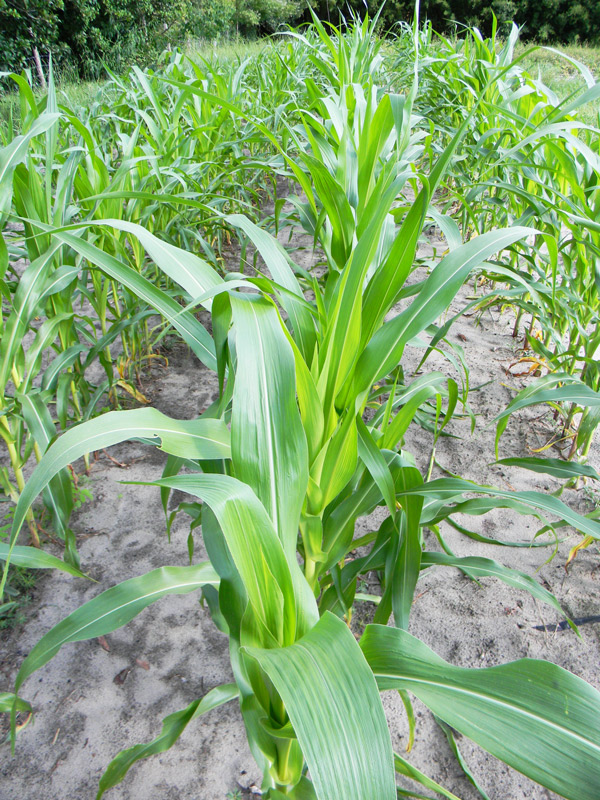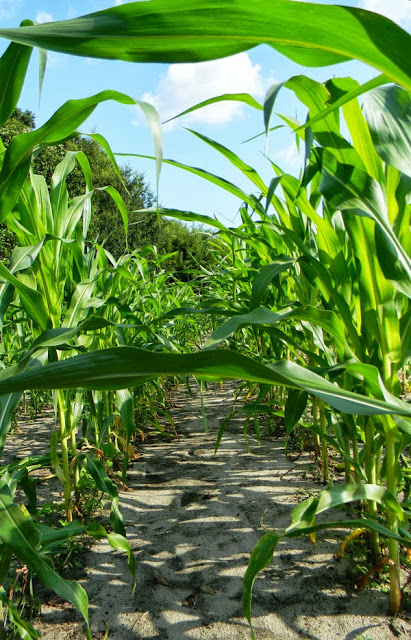Obviously, since I’ve noticed that, it makes me completely superficial.
Other grains don’t do it for me. They don’t look like jewels when they’re threshed, hulled, cleaned or whatever you need to do to them to get them ready for eating; corn, however, is in a class of its own.
That ear to the left? That isn’t sweet corn – it’s grain corn. Those kernels, though not completely dried yet, are really hard. The color is astounding, isn’t it? Like gold.
Growing Grain Corn for Survival
Sweet corn is for fun: grain corn is for survival.
The problem with corn is that it’s become a byword for the evils of modern agriculture. The plant has been used to make evil high-fructose corn syrup and had its genes scrambled into genetically modified variants that can stand being sprayed with poisons that would put us in a coma.
Corn is also a greedy crop that likes a lot of fertilizer as well as disturbed soil. When you grow it conventionally, you end up with erosion, run off, etc.
In another negative, corn, when used as a staple (and not nixtamalized), is also linked to pellagra, a niacin deficiency that can make you go nuts. You may even start daily gardening blogs.
BUT!
Corn also has a lot of positives going for it (other than being pretty).
It’s:
1. Easy to grow
2. Productive
3. Easy to clean and utilize
4. Storable
5. Calorie dense
6. A dense biomass producer
7. Great for chicken feed
8. Delicious
Corn isn’t quite as easy to grow in Florida as it is in some states. Sometimes extended rains will ruin some of your crop around harvest time… sometimes the bugs take over… and sometimes a nasty blast of wind will blow all your stalks sideways.
Yet even with those drawbacks, it’s usually simple to grow grain corn. Over the last couple of years, I’ve tested five different varieties here in North Central Florida: Hickory King, Tex Cuban, Floriani Red Flint, Green Dent and an un-named flint corn from the USDA germplasm repository.
 |
| Unnamed flint corn test bed. FAIL! |
Out of these, Tex Cuban and Hickory King stand head and shoulders above the rest. Both are “dent” corns, and both take a long time to produce. The green dent and the Floriani produced quickly – and poorly. They exhibited small ears with lots of skips, pest problems, less vigor and many stalks that failed to bear anything. The un-named flint corn was a total fail, which I blame on bad seed. In a really good bed they only grew a couple of feet tall and didn’t bother making ears. Heck with that. I’ll give both another try next year, but thus far I am not impressed.
Three years ago we had a great stand of Hickory King that produced excellently on tilled soil amended with cow manure. This year I planted Tex Cuban on tilled soil and fertilized it with chicken manure tea and it’s done quite well. The ears aren’t as large as the Hickory King ears, but that may be the result of genetic depression or lower soil fertility in the plot. It’s hard to tell when you don’t grow things side-by-side in the same season.
 |
| Tex Cuban corn kicking tail. |
All that stuff aside, grain corn is a lot easier to grow than sweet corn. It’s more tolerant of temperature fluctuations and pests, as well as lower soil fertility.
We don’t eat genetically modified foods, if we can help it, which means
I’ve been going without my beloved grits for years… except when I grow my own. The first time I ground grits from kernels harvested from my own garden, I was blown away by the rich corn flavor of homegrown
heirlooms. There’s nothing like it. Here’s how I make grits.
Interestingly, I’ve taken ears with me to church and other venues to show off. The question I usually get is “So what do you do with it?”
That’s the fun part. If you pick them in the “milk stage,” they make a decent, full-flavored sweet corn. In the mature stage, other than grits, you can turn the kernels into cakes, chips, tortillas, cornbread and other delicacies.
To grind the corn into meal or grits, one of these works fine. For finer grinds, though, you’ll need to get a better grinder. I have a Country Living Grain Mill which is supposed to grind corn (I have the right auger for it) yet refuses to do a decent job, probably because the relative humidity is too high. Whatever. You buy an expensive tool and think it’s just gonna work…
That aside, corn makes for great chicken feed if you “crack” it roughly in your mill so the birds can eat it. Whole kernels can be handled by larger birds, but I’d rather give them easier to handle sizes.
 Also, if you’re growing your own tobacco, corn cobs make great pipes to smoke it in. Who needs fancy imported briar from some fruity European nation? If corn cobs were good enough for General MacArthur, they’re more than good enough for me.
Also, if you’re growing your own tobacco, corn cobs make great pipes to smoke it in. Who needs fancy imported briar from some fruity European nation? If corn cobs were good enough for General MacArthur, they’re more than good enough for me.Incidentally, if you have them, small bamboo stems make good pipe stems, as do dry elderberry twigs or any other stick you can clean the center pith from. I’ve made my own pipes from various materials… and can attest to the fact that nothing tastes as pleasant as a corn cob.
A final note on corn: the stalks are great forage for grazing animals, as well as being a good addition to the compost pile. I stack them on the bottom of a new pile to add air, then pile smaller stuff on top. By spring you’ll have plenty of compost to feed the next crop of corn.
If you haven’t tried growing grain corn, give it a go. You might fall in love at first glance, just like I did.
SPUDOMETER RATING:
4 Spuds!
Name: Corn, dent
Latin Name: Zea Mays
Type: Annual
Size: 8-12′
Nitrogen Fixer: No
Medicinal: No
Cold-hardy: No
Exposure: Full sun
Part Used: Ears
Propagation: Seed
Taste: Good
Method of preparation: Young ears as a vegetable, mature kernels ground for flour and grits, cobs for smoking pipes.
Storability: Excellent when mature and dry
Ease of growing: Easy
Nutrition: So-so
Recognizability: High
Availability: High




18 comments
Excellent post! I'll (probably) give corn another go.
There are few plants that are more satisfying to grow. You pop them in the ground, they get really tall, then you harvest handfuls of jewels.
I’ll be completely unimaginative here and say, as long as I can boil, steam, or BBQ them and eat off the cob, I love corn. Wouldn’t think “seed” corn any different in these respects?
David, where did you get the seed for the varieties that did well for you?
Thanks!
Baker Creek is my main source for corn, though I get it from Southern Exposure Seed Exchange as well. The grain corn varieties are good for corn on the cob, but they’re starchy and savory rather than sweet. Any corn with butter and salt is goo, though!
I searched the Web and I am not coming up with a source to get Tex Cuban corn seeds. Your link is a bad link. Could you make a suggestion on where to get some? Or do they come with with another name?
I don’t think anyone has them anymore. It was an ECHO project in Ft. Myers, I think. You could try calling them.
We planted 3.3 acres of reis yellow dent in Marion county Florida this year. Not sure yet how it is going to do. Looks good now.
Excellent. Good luck. Dent corn did great for me in Marion county.
Hi
I cant find “Tex cuban corn” online. Does it have another name? Thanks.
No. No one seems to have it anymore.
David,
Greetings from Cocoa Florida. Did an experiment with corn some Hickory Cane Dent Corn, half in corn mounds, half in corn pits with limited additives other than double digging the mounds/ pits and adding a smidge of compost on the top. Anywho, after 4-5 very rainy days, I went and checked on my corn and low and behold majority of it has lots of holes in leaves and worm poop on the leaves and in the middle of the leaf bud. Ever have issues with army worms or other caterpillars munching your corn? Gonna try treating with BT tonight, but man I hate spraying things on mah plants. I trusted you David…. You said grain corns were easier than sweet corns….. Just kidding, but really where did I go wrong? First time growing corn period. Hope all is well.
bT isn’t that bad. I never had that particular issue – I am sorry! I did get weird aphid infestations occasionally. The trick in Florida seems to be to plant as early in the year as possible to beat the bugs. When I planted corn later it would have all kinds of issues.
Am I a day late and dollar short? LOL. I’m over in the center of the state z9-b. I planted dent corn this spring, and it grew FAST and now I sit with some fallen over stalks, but lots of tassels- BIG huge pretty tassels. Some of the standing corn is 10 foot tall…YAY? Well it would be is there was a single ear of corn! Zip, none!!! I STILL want to try again. Should I give it another shot in August? I got a new batch of seeds from a different vendor. Not sure if it was bad seed, bad watering/lack of rain or what, but I’m not ready to give up , yet. Your thoughts?
Mine is just starting to make ears now. Dent corn takes its time.
I don’t know if you’ll have luck planting another round later. It’s usually just a spring-planted crop in FL.
I usually plant my grain corn as soon as the first rains in June all the way through mid August. I’m in Central Florida. Another advice don’t till in florida soil, we have sand, tilling will burn off what ever little organic matter is in the soil and also make it dry real fast, it’s absolutely nonsensical. Also grow it in clusters (hills, though they don’t need to be mounded) like the Indians did, there is a reason why they did so. I’ve been growing it like that and never had problems ground cover.
Fall army worms usually arrive by the V4 stage, BT and spinosad are the best organic treatments. Once the plant is grown it can fend for itself better assuming you are growing it without strong all vegetation from the ground, I get lots of insects that eat them.
Try growing cowpeas at the base to create a dense groundcover and keep weeds at bay it’s not necessary to wipe every single one out.
I will try some on mounds again. Thank you for letting me know you were still able to grow corn this late in the year. We did mounds on clay soil in the tropics with some luck.
UFAS says that in 10b SWFL corn can be planted in October, but I am nervous. Was gifted some heirloom grain corn which was successfully grown in Ft. Myers. Have a 10’x15′ space in full sun. Debating rows 3′ apart or holes of 4, 3′ apart…
Unless you get one of those “once in a decade or more” frost events, it’s worth trying. We grew our tomatoes through winter. We tried both stations and rows and had similar yields this summer.
Comments are closed.